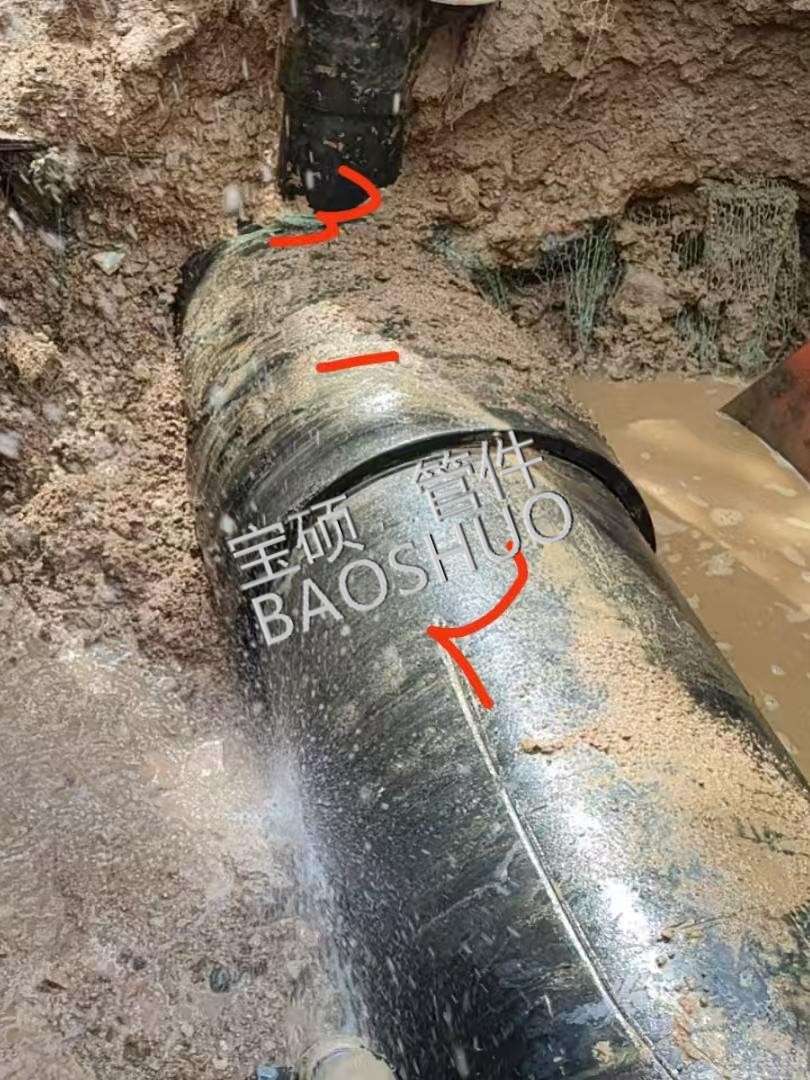DN1000 ductile iron pipe socket connection leakage, maintenance methods, connection principle
🧿 1. Principle of Socket-and-Spigot Connections (Primarily T-Type Joints)
The socket-and-spigot connection for ductile iron pipes utilizes a T-shaped flexible joint (slip-on joint). Its core sealing mechanism relies on the self-sealing mechanism of the rubber ring:
Structural Components:
- Socket: An internal annular groove secures the rubber ring.
- Spigot: A smooth outer wall compresses the rubber ring during insertion.
- Rubber ring: Typically a composite structure of hard rubber and soft rubber. The hard rubber provides support, while the soft rubber deforms under pressure to achieve a seal.
Sealing Mechanism:
- When the spigot is inserted into the socket, the rubber ring is radially compressed, generating initial contact pressure.
- After water is flowing, water pressure pushes the rubber ring further against the socket-and-spigot gap, forming a water-pressure-enhanced seal (the greater the pressure, the tighter the seal).
- Axial displacement (~10mm) and deflection angle (~3°) are permitted to accommodate foundation settlement or thermal expansion and contraction.
Common Causes of Leaks:
- Aging, cutting, or misaligned rubber rings;
- Foundation settlement causing socket-spigot misalignment beyond the allowable range;
- Excessive joint deflection or improper insertion of the spigot.

🧿 II. DN1000 Pipe Leak Repair Methods
Depending on the location and severity of the leak, the following repair techniques are available:
Baoshuo Socket-Spigot Repair Clamp (Baoshuo Clamp, Baoshuo Brand Emergency Repair Clamp)
- Applicable Scenario: Leaks at spigot-spigot joints require no water shutoff and can be repaired under running water and pressure. Customizable for any pipe size, DN50-4000mm.
- Steps:
① Clean the surface of the leak;
② Wrap the two halves of the repair clamp around the leaking socket and tighten with bolts;
③ A secondary seal is formed by squeezing the internal rubber gasket. Baoshuo's spigot repair clamps can be customized with rubber that is resistant to high temperatures, oils, acids, and alkalis. - Advantages:
- 15-30 minutes to complete, easy to use (depending on pipe size);
- Supports pressurized operation (≤1.6 MPa). For pipes exceeding 1.6 MPa, choose Baoshuo high-pressure repair clamps.
- Limitations: For pipes that are already out of round, even half-joints are difficult to fix.
Glue Injection Method (Internal Sealing Enhancement)
- Applicable Scenario: Minor rubber ring failure or gap leakage.

- Procedure:
① Drill a glue injection hole (lower hole) and a glue overflow hole (upper hole) in the socket;
② Insert a filling airbag into the socket gap to temporarily seal it;
③ Inject two-component polysulfide sealant through the glue injection hole until glue comes out of the glue overflow hole;
④ Remove the airbag after curing for 24 hours. - Advantages:
- Sealing compound lifespan is approximately equal to that of the rubber ring, ensuring long-term reliability;
- Does not change the pipe inner diameter, preventing flow loss.
Internal Component Replacement (Applicable to K2-Type Interfaces)
- Applicable scenario: Failed rubber rings on large-diameter (DN1000) K2-Type interfaces.
- Operation steps:
① Drain the pipeline and enter the pipe;
② Remove the pressure ring, assembly ring, and old rubber ring;
③ Replace the new rubber ring, installing the assembly ring (3 sections) → the pressure ring (4 sections) → tightening the bolts.
- Advantages:
- Avoids excavation, ensuring precise repairs;
- Suitable for complex interface structures.
> 💎 Key Decision Factors:
> - Water outage feasibility: Repair clamps and injection methods can be used without shutting down the water supply; internal replacement requires draining the pipeline. Leakage Scope: For localized external leakage, repair clamps should be used; for internal seal failure, injection molding or component replacement should be used.
- Pipe Diameter Limitations: For large-diameter pipes such as DN1000, internal repair or flange conversion is preferred.
💎 III. Preventive Measures
- Installation Phase:
- Lubricate the working surface of the socket and spigot to prevent cutting of the rubber ring;
- Control the insertion depth of the spigot and allow for deflection.
- Operation and Maintenance Phase:
- Regularly monitor interface displacement (e.g., by attaching strain gauges);
- Install anti-slip support piers in geologically unstable areas.
By matching the cause of the leak with the repair technique, DN1000 ductile iron pipe socket and spigot leakage can be effectively resolved. Trenchless techniques (such as repair clamps or injection molding) are preferred to reduce maintenance costs. Major structural damage requires flange conversion or internal reconstruction.











